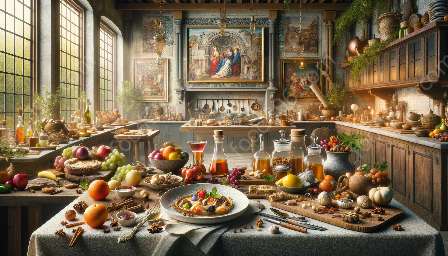The Renaissance period marked a time of cultural, artistic, and culinary innovation. The culinary landscape of this era was shaped by regional variations that showcased diverse cooking styles, ingredients, and flavors. In this comprehensive exploration, we delve into the captivating world of Renaissance cuisine to understand the regional differences and their significance in the history of culinary arts.
The Renaissance Cuisine History
Before delving into the regional variations, let's first understand the historical context of Renaissance cuisine. The Renaissance, occurring from the 14th to the 17th century, brought about a surge of creativity and ingenuity, not only in art and literature but also in the culinary domain. This period witnessed a flourishing of trade, exploration, and cultural exchange, all of which left a profound impact on the evolution of cuisine.
Renaissance cuisine was characterized by an emphasis on lavish banquets, the use of exotic spices, and the development of intricate cooking techniques. It was during this time that the concept of fine dining and gastronomy began to take shape, laying the foundation for the culinary traditions we cherish today.
Cuisine History
To fully appreciate the significance of regional variations in Renaissance cuisine, it is essential to explore the broader history of cuisine. Throughout human history, food has been integral to cultural identity, and the evolution of cuisine has been shaped by a myriad of factors, including geographical location, climate, trade routes, and sociocultural influences.
The history of cuisine is a tapestry woven with the threads of diverse culinary traditions, each contributing to the rich tapestry of global gastronomy. From the early agricultural societies to the contemporary fusion kitchens, the journey of cuisine reflects the interplay of people, places, and palates.
Understanding Regional Variations in Renaissance Cuisine
One of the most intriguing aspects of Renaissance cuisine is the prevalence of regional variations. The culinary landscape of Renaissance Europe was far from homogenous, with each region boasting its own unique culinary heritage. These regional variations were influenced by a multitude of factors, including local produce, cultural practices, and historical influences.
Italy: The Epicenter of Culinary Diversity
Italy, often regarded as the epicenter of Renaissance cuisine, can be likened to a culinary mosaic, with each region contributing distinct flavors and culinary traditions. The Italian peninsula, comprising regions such as Tuscany, Lombardy, and Sicily, gave rise to an array of regional dishes that showcased the diversity of Italian gastronomy.
Tuscany, known for its fertile farmlands and abundance of produce, gave birth to rustic yet robust dishes such as ribollita and pappa al pomodoro. On the other hand, the maritime influence in Sicily resulted in seafood-centric delicacies like sarde a beccafico and pasta con le sarde. Lombardy, with its rich dairy heritage, crafted delectable dishes such as risotto alla milanese, elevating the art of rice-based cuisine.
France: Gastronomic Grandeur Across Regions
France, renowned for its culinary prowess, also exhibited a remarkable diversity of regional cuisines during the Renaissance. From the refined elegance of French court cuisine to the hearty fare of the countryside, each region contributed distinct flavors and culinary techniques.
In the northern regions, such as Normandy and Brittany, the abundant supply of seafood gave rise to delectable dishes like moules marinières and coquilles Saint-Jacques. In the southern regions, the influence of Mediterranean flavors and ingredients shaped dishes such as ratatouille and bouillabaisse, epitomizing the culinary richness of Provencal cuisine.
Spain: A Tapestry of Culinary Traditions
Spain, with its diverse regional identities, also showcased a tapestry of culinary traditions during the Renaissance. The culinary landscape of Spain was influenced by the interplay of Moorish, Jewish, and Christian culinary practices, each contributing to the vibrant mosaic of Spanish cuisine.
In the fertile plains of Andalusia, dishes such as gazpacho and salmorejo highlighted the region's reliance on fresh produce and vibrant flavors, while in Catalonia, the marriage of land and sea gave birth to iconic dishes like paella and calcots.
Impact on Culinary History
The regional variations in Renaissance cuisine left an indelible mark on the history of culinary arts. These divergent culinary traditions not only enriched the gastronomic landscape of the Renaissance but also laid the groundwork for the development of national and international cuisine.
The exchange of ingredients, cooking techniques, and culinary customs between regions fostered a cross-pollination of flavors, leading to the emergence of new culinary innovations. Furthermore, the regional variations in Renaissance cuisine paved the way for the concept of terroir, emphasizing the unique influence of local environmental factors on food production and flavor profiles.
Conclusion
Exploring the regional variations in Renaissance cuisine unveils a captivating tapestry of flavors, techniques, and cultural influences. The rich diversity of culinary traditions that flourished during this period continues to inspire modern-day gastronomy, reminding us of the enduring legacy of regional cuisines. From the fertile lands of Italy to the coastal corners of France and Spain, the culinary heritage of the Renaissance remains a testament to the enduring power of regional variations in shaping the history of cuisine.

